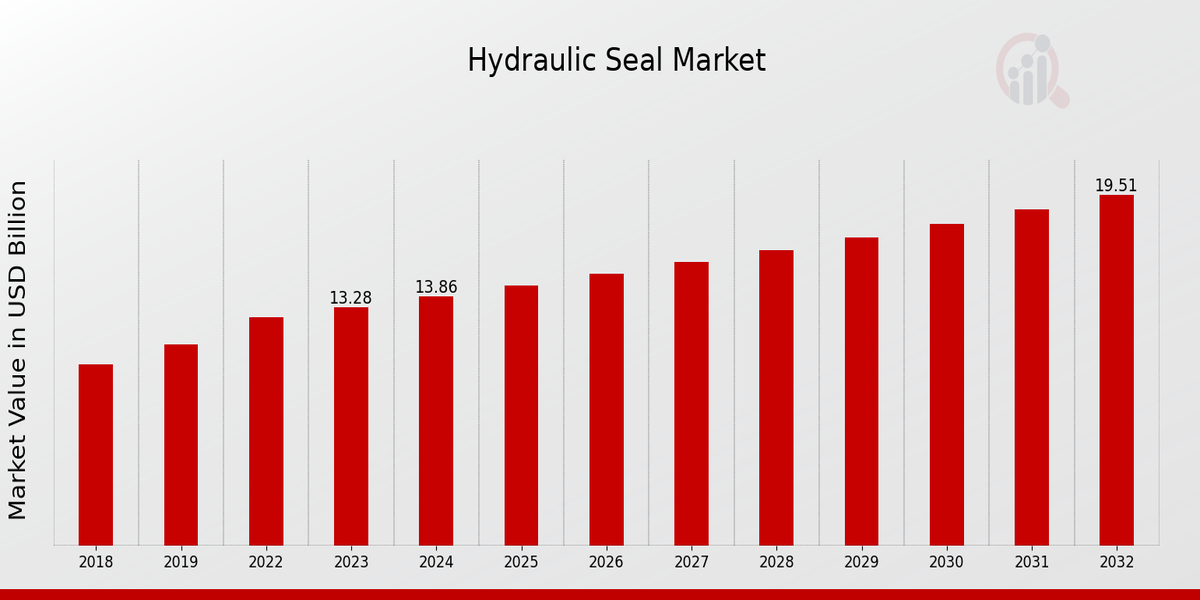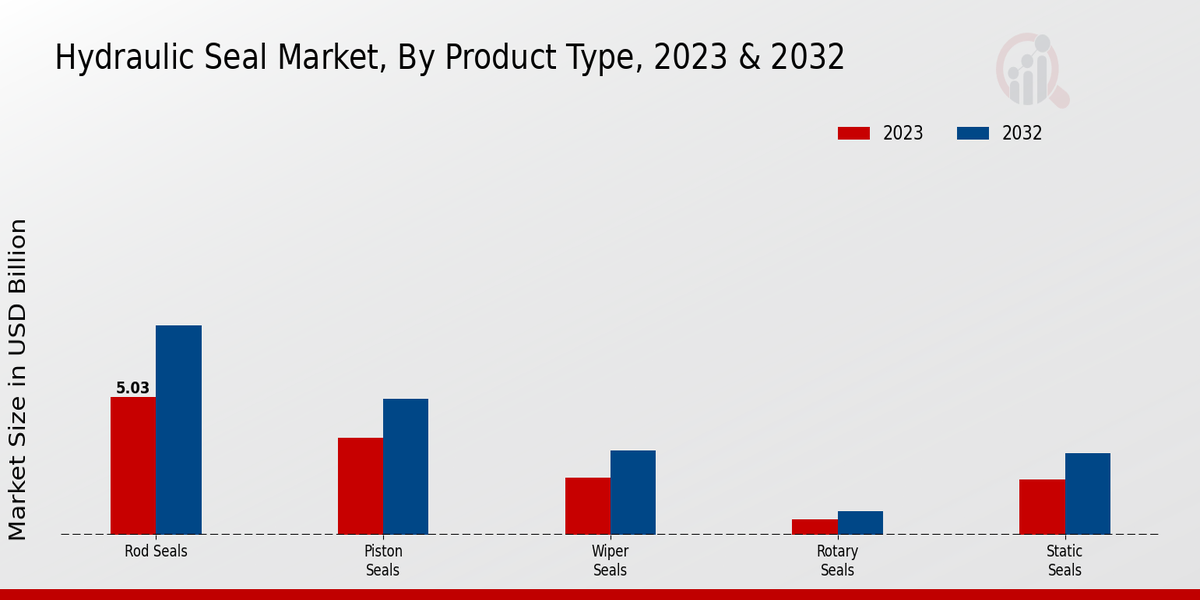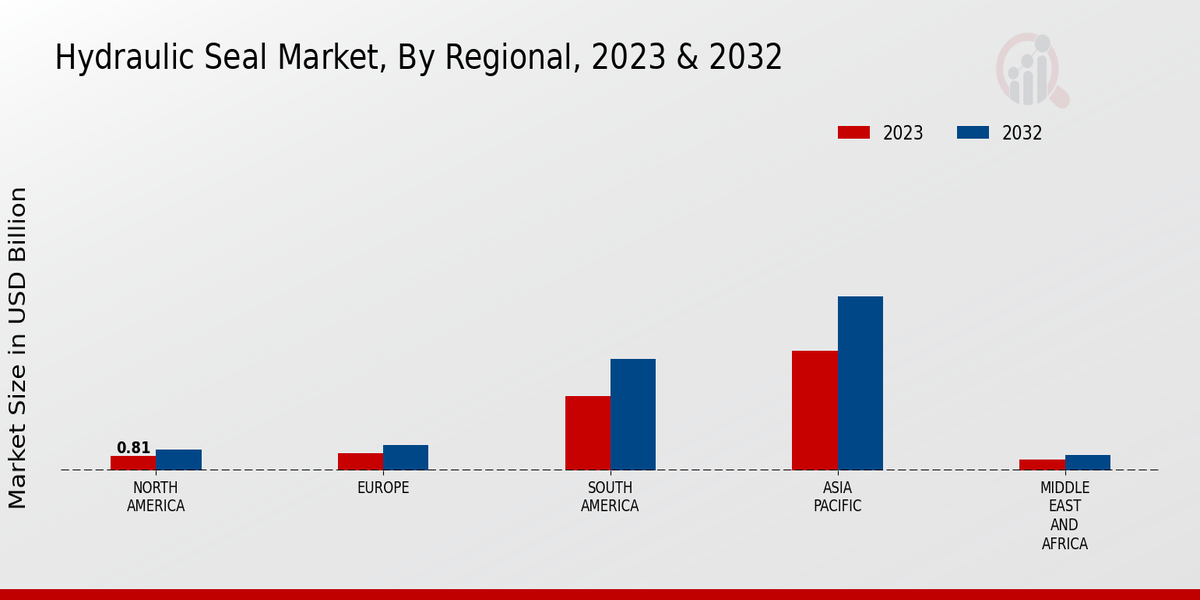Global Hydraulic Seal Market Overview
The Hydraulic Seal Market Size was estimated at 14.47 (USD Billion) in 2024.The Hydraulic Seal Industry is expected to grow from 15.10 (USD Billion) in 2025 to 22.18 (USD Billion) by 2034. The Hydraulic Seal Market CAGR (growth rate) is expected to be around 4.4% during the forecast period (2025 - 2034).
Key Hydraulic Seal Market Trends Highlighted
Rising automation across industries, particularly in manufacturing and automotive sectors, is expected to drive the demand for hydraulic seals. The proliferation of heavy machinery and equipment in construction, mining, and agriculture is further stimulating market growth. Additionally, the growing focus on energy efficiency in hydraulic systems is propelling the adoption of advanced and innovative sealing solutions.
Environmental regulations and initiatives to reduce fluid leakage and emissions are also creating opportunities for hydraulic seal manufacturers. The demand for bio-based and eco-friendly seals that minimize environmental impact is on the rise. Furthermore, the increasing adoption of predictive maintenance and condition monitoring technologies is expected to drive the demand for sensors and intelligent seals that can provide real-time data on seal performance and health.

Source: Primary Research, Secondary Research, MRFR Database and Analyst Review
Hydraulic Seal Market Drivers
Growing Demand for Hydraulic Systems in Industrial Applications
The Hydraulic Seal Market is primarily driven by the increasing demand for hydraulic systems in various industrial applications. Hydraulic systems are widely used in heavy machinery, construction equipment, agricultural machinery, and manufacturing equipment. These systems require high-quality seals to prevent leakage and maintain system performance. The growing emphasis on automation and the increasing adoption of hydraulic systems in emerging economies are expected to further drive the demand for hydraulic seals in the coming years.Moreover, the rising demand for energy-efficient and environmentally friendly hydraulic systems is also contributing to the growth of the hydraulic seal market, as these systems require specialized seals to meet stringent performance and environmental standards.
Technological Advancements and Innovation
The hydraulic seal market is witnessing rapid technological advancements and innovation. Manufacturers are continuously developing new materials and designs to improve the performance, durability, and efficiency of hydraulic seals. The adoption of advanced materials, such as fluorocarbon elastomers and polytetrafluoroethylene (PTFE), is enabling the production of seals that can withstand extreme temperatures, pressures, and chemical environments.
Additionally, the integration of sensors and monitoring systems into hydraulic seals is enhancing their functionality and allowing for real-time monitoring of system performance. These advancements are expected to drive the adoption of innovative and high-performance hydraulic seals across various industries.
Increasing Focus on Reliability and Safety
The provision of safety and reliability in hydraulic systems is of overall importance, and hydraulic seals should be mentioned among the critical components of these systems, which provide both the safety and efficient system’s run. The fact is that industrial enterprises pay more and more attention to the issue of reliability and safety and, hence, begin to demand hydraulic seals of high quality and reliability. The improvement of seals refers to the area of their safety, which is associated with their ability to provide safe operation under a number of operational factors.At the same time, specialists pay increased attention to monitoring the conditions of seals and systems, promoting the need for early failure detection. This measure will minimize system downtime and, hence, improve the safety and reliability of seals in general.
Hydraulic Seal Market Segment Insights
Hydraulic Seal Market Product Type Insights
The Hydraulic Seal Market segmentation by product type includes rod seals, piston seals, wiper seals, rotary seals, static seals, and other seals. Among all these, the rod seals held the largest market share in 2023 and are expected to remain dominant over the forecast period. The growth in the segment can be attributed to the rising demand for rod seals in various industrial applications, including hydraulic cylinders, pumps, and valves. Piston seals are the second major surface in the product segment. Wiper seals are estimated to witness steady growth over the forecast period because they are increasingly being adopted by various end-users in their hydraulic systems to prevent contaminants.Rotary seals are also likely to gain traction because they are used to seal rotating shafts and prevent leakage. Static seals will not witness very significant growth over the forecast period because they are largely confined to static applications, such as sealing flanges and joints. Growth in the market is caused by the increasing demand for hydraulic seals from major end-use applications, such as construction, manufacturing, automotive, and aerospace. The expansion of the market is also caused by the increasing reliance of end-users on hydraulic systems that should be adequately sealed to prevent leakage and avoid contamination.

Source: Primary Research, Secondary Research, MRFR Database and Analyst Review
Hydraulic Seal Market Material Insights
The Hydraulic Seal Market is divided by Material into Elastomers, Polyurethanes, PTFE, Thermoplastics, and Metal. Elastomers create an over hundred percent segment of the market due to their numerous advantages, such as flexibility, low and high-temperature resistance, durability, and high rate of isolation from mechanical influence. The second most popular material for hydraulic seals is polyurethane which gains its popularity due to high strength and resistance to hydraulic fluids. PTFE is a fluoropolymer that is used in seals that require high chemical resistance and low friction.Thermoplastics are used in seals, which require high-temperature resistance and low permeability. Metal is used in places with high pressure and temperature requirements. The market is going to grow within the upcoming decade since the need for hydraulic systems is increasing. The current Hydraulic Seal Market is highly divided between Elastomers and Polymers (mostly polyurethane), with the clear advantage of elastomers. Despite their much greater share of the market, elastomers are still predicted to be in high demand due to their superiority, while polymers’ dominance in the rest of the market is going to increase.
Hydraulic Seal Market Application Insights
The Hydraulic Seal Market is segmented into various applications, including industrial machinery, automotive, aerospace, oil gas, construction, and medical devices. Each segment presents unique growth opportunities and challenges.
The industrial Machinery segment accounts for a significant share of the Hydraulic Seal Market revenue, driven by the growing demand for hydraulic systems in industrial equipment. The increasing adoption of automation and the need for efficient fluid power solutions contribute to the segment's growth.
Hydraulic seals play a crucial role in automotive applications, ensuring the leak-free operation of hydraulic systems in vehicles. The rising production of automobiles, particularly in emerging markets, is expected to drive segment growth.
The aerospace industry relies heavily on hydraulic systems for various applications, including flight controls, landing gear, and hydraulic power units. The increasing demand for commercial and military aircraft is anticipated to boost the demand for hydraulic seals in the aerospace segment.
Hydraulic seals are essential components in oil and gas exploration and production operations. They prevent leakage and ensure the efficient operation of hydraulic systems in drilling, extraction, and transportation equipment. The fluctuating oil and gas prices and the growing focus on offshore exploration are key factors influencing segment growth.
Hydraulic seals are utilized in construction equipment, such as excavators, bulldozers, and cranes. The increasing infrastructure development and urbanization projects worldwide are expected to drive demand for hydraulic seals in the construction segment.
The medical industry uses hydraulic seals in various medical devices, including surgical tools, diagnostic equipment, and patient care devices. The growing demand for minimally invasive procedures and the increasing number of surgical interventions are contributing to the growth of this segment.
Hydraulic Seal Market Pressure Rating Insights
The Hydraulic Seal Market revenue for the Pressure Rating segment is expected to witness substantial growth over the next few years. In 2023, the market for low-pressure seals (up to 10 bar) was valued at around USD 3.4 billion and is projected to reach USD 5.2 billion by 2032, exhibiting a CAGR of 4.7%.
Medium-pressure seals (10 to 100 bar) are also witnessing a steady rise, with the market valued at USD 4.6 billion in 2023 and projected to reach USD 7.1 billion by 2032, showcasing a CAGR of 4.9%. High-pressure seals (over 100 bar) currently hold a significant market share and are estimated to grow from USD 6.2 billion in 2023 to USD 9.5 billion by 2032, reflecting a CAGR of 4.4%.Ultra-high-pressure seals (over 1,000 bar) represent a growing segment, with the market projected to expand from USD 1.8 billion in 2023 to USD 2.8 billion by 2032, indicating a CAGR of 5.1%. These seals cater to demanding applications in industries such as oil and gas, aerospace, and heavy machinery.
Hydraulic Seal Market Regional Insights
The Hydraulic Seal Market is segmented into North America, Europe, APAC, South America, and MEA. Among these regions, North America is expected to hold the largest market share in 2024, followed by Europe and APAC. The growth in North America is attributed to the increasing demand for hydraulic seals in the automotive and industrial sectors.
Europe is also a significant market for hydraulic seals, driven by the presence of major automotive and manufacturing industries. The APAC region is expected to witness significant growth in the coming years due to the increasing industrialization and infrastructure development in countries such as China and India.South America and MEA are expected to have a moderate growth rate, driven by the increasing demand for hydraulic seals in the mining, oil and gas, and construction industries.

Source: Primary Research, Secondary Research, MRFR Database and Analyst Review
Hydraulic Seal Market Key Players And Competitive Insights
Many top Hydraulic Seal Market companies are seeking to enhance their market position in the industry by investing in research and development. These companies are also looking to drive growth in their worldwide activities by either acquiring existing market players or entering into partnerships.
The Hydraulic Seal Market industry is largely fragmented and a number of smaller and mid-sized players operate along with a handful of multinational firms. These major firms are concentrating on launching new products and expanding their product portfolio, as well as extending their global reach to meet clients’ varying needs. Major drivers of the Hydraulic Seal Market industry include increasing demand from numerous end-use sectors, ongoing product advancements, and rising awareness about the significance of the Hydraulic Seals Market in maintaining system efficiency.
Parker Hannifin Corporation is a leading global provider of motion and control technologies and other hydraulic seals. The company offers a broad array of hydraulic seals, including O-rings, gaskets, and piston seals, customized to suit the particular needs of numerous industries. Parker Hannifin is present in over 50 countries and serves a range of applications, including those related to industrial equipment, aerospace, and automotive. Parker is a leading Hydraulic Seals Market player because it is dedicated to ongoing product innovation and refining and to paying close attention to the needs and preferences of its customers.
SKF is a Swedish multinational enterprise that manufactures bearings, seals, and other precision engineering goods. The company’s Hyundai-honed division provides a diverse range of hydraulic seals, including piston, rod, and rotary seals, for use in various industries. The products are used by several industries, such as those focusing on products for automotive, aerospace, and renewable energy. Finally, SKF can compete as a universal leader in the Hydraulic Seals Market industry because of the company’s focus on product quality and advances.
Key Companies in the Hydraulic Seal Market Include
- Hydac International
- EagleBurgmann
- Chesterton International
- Trelleborg Sealing Solutions
- Garlock Sealing Technologies
- Apple Rubber Products
- Bishop Hydraulics
- Freudenberg Sealing Technologies
- Hallite Seals International
- Dichtomatik
- SKF Grou
- NOK Corporation
- Parker Hannifin
- Pactiv Evergreen
- James Walker
Hydraulic Seal Market Industry Developments
The Hydraulic Seal Market size was valued at USD 13.28 billion in 2023 and is projected to reach USD 19.5 billion by 2032, exhibiting a CAGR of 4.36% during the forecast period. The growth of the market is attributed to the increasing demand for hydraulic seals in various industries, including construction, mining, and manufacturing.Recent news developments in the market include the launch of new products and technologies by major players. For instance, in 2023, Trelleborg Sealing Solutions introduced a new range of hydraulic seals designed to meet the demands of high-pressure applications in the mining industry. Additionally, the growing adoption of automation and robotics in industries is expected to drive the demand for hydraulic seals in the coming years.
Hydraulic Seal Market Segmentation Insights
- Hydraulic Seal Market Product Type Outlook
- Rod Seals
- Piston Seals
- Wiper Seals
- Rotary Seals
- Static Seals
- Other
- Hydraulic Seal Market Material Outlook
- Elastomers
- Polyurethanes
- PTFE
- Thermoplastics
- Metal
- Hydraulic Seal Market Application Outlook
- Industrial Machinery
- Automotive
- Aerospace
- Oil Gas
- Construction
- Medical Devices
- Hydraulic Seal Market Pressure Rating Outlook
- Low Pressure (up to 10 bar)
- Medium Pressure (10 to 100 bar)
- High Pressure (over 100 bar)
- Ultra-high pressure (over 1,000 bar)
| Report Attribute/Metric |
Details |
| Market Size 2024 |
14.47 (USD Billion) |
| Market Size 2025 |
15.10 (USD Billion) |
| Market Size 2034 |
22.18 (USD Billion) |
| Compound Annual Growth Rate (CAGR) |
4.4% (2025 - 2034) |
| Report Coverage |
Revenue Forecast, Competitive Landscape, Growth Factors, and Trends |
| Base Year |
2024 |
| Market Forecast Period |
2025 - 2034 |
| Historical Data |
2020 - 2024 |
| Market Forecast Units |
USD Billion |
| Key Companies Profiled |
Hydac International, EagleBurgmann, Chesterton International, Trelleborg Sealing Solutions, Garlock Sealing Technologies, Apple Rubber Products, Bishop Hydraulics, Freudenberg Sealing Technologies, Hallite Seals International, Dichtomatik, SKF Grou, NOK Corporation, Parker Hannifin, Pactiv Evergreen, James Walker |
| Segments Covered |
Product Type, Material, Application, Pressure Rating, Regional |
| Key Market Opportunities |
Growing demand for hydraulic equipment in various industries Technological advancements leading to improved seal performance and efficiency Increasing focus on energy efficiency and reduced downtime Rise in offshore and subsea applications. Expansion of the construction and infrastructure sector |
| Key Market Dynamics |
Increasing demand for hydraulic systems in industrial machinery Growing adoption of hydraulic seals in mobile hydraulics Rising infrastructure development and construction activities Stricter environmental regulations driving demand for eco-friendly seals Technological advancements leading to improved seal performance and durability |
| Countries Covered |
North America, Europe, APAC, South America, MEA |
Frequently Asked Questions (FAQ) :
The Hydraulic Seal Market is expected to be valued at USD 14.47 billion in 2024 and is projected to grow at a CAGR of 4.4% from 2025 to 2034, reaching a value of USD 22.18 billion by 2034.
North America is expected to hold the largest market share in 2024, followed by Europe and APAC. The region's growth is attributed to the increasing demand for hydraulic seals in various industries, including automotive, construction, and manufacturing.
Hydraulic seals are primarily used in hydraulic systems to prevent leakage and maintain pressure. They find applications in a wide range of industries, including automotive, aerospace, construction, and manufacturing.
Major players in the Hydraulic Seal Market include SKF, Trelleborg, Parker Hannifin, Freudenberg, Enpro Industries, Hallite, EagleBurgmann, James Walker, and Chesterton.
Key factors driving the growth of the Hydraulic Seal Market include increasing demand from the automotive industry, growing adoption in industrial applications, rising demand for hydraulic seals in emerging economies, technological advancements leading to improved performance and efficiency
The Hydraulic Seal Market faces certain challenges, including fluctuating raw material prices, competition from alternative sealing technologies, stringent regulatory requirements, environmental concerns related to the use of certain materials
Key trends shaping the hydraulic seal market include, adoption of predictive maintenance and industry 4.0, development of new materials and technologies, growing emphasis on sustainability and environmental friendliness, increasing demand for customized and specialized hydraulic seals.
The COVID-19 pandemic had a significant impact on the Hydraulic Seal Market, leading to a decline in demand due to disruptions in supply chains, production shutdowns, and reduced industrial activities. However, the market is expected to recover as industries resume operations and economies rebound.
The Hydraulic Seal Market is expected to witness steady growth in the coming years, driven by factors such as increasing industrialization, rising demand from emerging economies, and technological advancements. The market is expected to reach a value of USD 22.18 billion by 2034, growing at a CAGR of 4.4% from 2025 to 2034.
When selecting a Hydraulic Seal, key factors to consider include size and dimensions, pressure rating, temperature range, chemical compatibility, material properties, seal type, and cost.

















